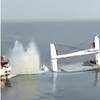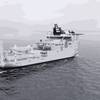Feature: Dynamic Positioning An Amenity Becomes Compulsory
The inclusion of dynamic positioning systems has become a standard and necessary system on supply boats and many crew/supply vessels.
In their simplest form, dynamic positioning systems allow an offshore vessel to "moor" adjacent to a rig or platform without the traditional mooring lines being attached to structure or the use of anchors. Instead thrusters both in the bow and the stern keep the vessel on station.
For a more precise definition of dynamic positioning, American Bureau of Shipping (ABS) says, "The dynamic positioning system is a hydrodynamic system which controls or maintains the position and heading of a vessel by centralized manual control or by automatic response to the variations of the environmental conditions (wind speed, current, wave height) within the specified limits."
The Oil Companies and DP
The development of dynamic positioning systems and the use of them on every new supply vessel being built has a lot to do with the oil companies who own the structures being serviced by the vessels. These companies, with billion of dollars invested in their drilling and production equipment in the Gulf of Mexico (GOM) and elsewhere have insisted that the offshore vessel operators not tie up to their rigs and be able to transfer materials to the platform in advance sea states.
The only practical was to way to affect this transfer is to use dynamic positioning systems.
Oil companies simply will not accept transfer of drilling fluids and other cargoes to their rig or platform without the assurance that the vessel supplying these materials is equipped with dynamic positioning equipment and therefore minimizes the risk that material flow to the offshore structure will be interrupted by wave action or wind. The DP system also minimizes the chance that the vessel will strike the rig/platform during the material transfer.
The rigs and production platforms in the GOM all have sophisticated dynamic positioning systems and now the vessels that supply them must have at least basic dynamic positioning systems.
DP and Older Supply Boats
One of the collateral issues surrounding the "standardization" of dynamic positioning systems on GOM is that it is hastening the obsolescence of older supply boats in the GOM fleet. For example, when Larry Rigdon, an ex-Tidewater executive, decided to startup an offshore supply company, he found the financing for 10 new 210-foot vessels with advanced dynamic positioning systems, rather than begin with older existing vessels that might have similar deadweight capacities, but not have dynamic positioning capabilities.
"I am making a bet that advanced technology vessels with superior dynamic positioning capabilities are the wave of the future," Rigdon explained.
Even well established companies have cast a wary eye at their supply vessels without dynamic positioning. For example, Ensco Marine, Broussard, La. just finished a program of stretching six existing vessels to increase their mud capacity, reengine the vessels and retrofit an advanced dynamic positioning system. The sale of the entire Ensco fleet of 27 OSVs to Tidewater may not have been possible if Ensco had not upgraded these six vessels with advanced dynamic positioning.
Class by ABS
Dynamic positioning systems have four class notations assigned by ABS. The classes are DP-0, DP-1, DP-2 and DP-3. The higher the number after the DP notation, the greater degree of redundancy is built into the system and typically the farther from shore a vessel can operate. That is, a class DP-2 platform supply vessel is one that can operate on the shelf but is typically used in deepwater where weather conditions are more severe.
For all practicality, only DP-1 and DP-2 systems are being fitted on OSVs today and are the focus of this article. DP-0 systems have no built in redundancy and therefore are seldom used and DP-3 systems are typically used on drilling rigs and on some North Sea vessels. DP-3 systems require great redundancy and separate compartments with A-60 walls for generators, prime movers, switchboards and most other DP components.
The chart "Comparison of Different ABS Classifications for DPS" summarizes basic requirements for DP-0, DP-1 and DP-2 systems.
Diagrams "Typical Class 0 System" "Typical Class 1 System" and "Typical Class 2 System" (above) show in a flow diagram mode the various components of DP-0, 1 and 2 systems and how they are interconnected.
DP and Tidewater
"DP systems have evolved over time," said E. J. Hebert, VP of Technical Services for Tidewater. "The built in redundancy of DP-2 systems comes with a cost, such as a second bow thruster and more environmental sensors," Hebert added.
"The main concept behind DP-2 systems is to supply enough redundancy that if a single point failure occurs (such as the loss of a bow thruster), the vessel can still keep station," Hebert said.
Companies such as Tidewater are designing DP systems into their vessels that are DP-1 but can be upgraded to DP-2. "We are building a series of six OSVs at Bender with two tunnel bow thrusters, but only rated at DP-1," Hebert noted. " These vessels can be upgraded to DP-2 without dry docking the boat to add a second bow thruster," Hebert said.
Most of the new vessels that Tidewater are building in the 207-220-foot range have Z-drives as the main propulsion, eliminating the need for separate stern thrusters. In the bow, the Tidewater vessels utilize a drop-down bow thruster or a pair of conventional tunnel thrusters. "This is a design we have settled on and one we think will work well for us in the future," Hebert added.
The use of 360-degree azimuthing thrusters has been growing in use. The vessel operators want the enhanced maneuverability these thrusters offer and they also work very well with DP-1 or DP-2 systems. For example, the new series of 207-foot supply boats Bollinger is building for Tidewater has a 360 degree drop-down thruster in the bow and the twin Z-drives in the stern are also azimuthing thrusters. "These type of thrusters offer optimum vessel control and maneuverability," said Trish McIntyre, principal engineer machinery technical of ABS in New Orleans. "We see a lot more of these thrusters on both supply and crew/supply vessels," McIntyre added.
DP and the Coast Guard
Last October the 8th Coast Guard District (New Orleans covering the GOM) issued a guidance letter regarding the "USE OF DYNAMIC POSITIONING BY OFFSHORE SUPPLY VESSELS FOR OIL AND HAZMAT TRANSFERS."
In the letter, the 8th District noted the move to deeper water on the Outer Continental Shelf had made conventional mooring systems obsolete.
The Coast Guard referred to its 33 CFR 156.120(a) that required that during oil and HAZMAT transfers "the vessel's moorings are strong enough to hold during all expected conditions of surge, current and weather." Obviously this regulation was written before the introduction of DP on offshore supply vessels and the purpose of the letter was to inform those operating in the Gulf of Mexico the type of DP systems would be acceptable to the Coast Guard.
The Coast Guard developed four alternatives that are generally parallel with ABS and IMO classifications.
• Alternative #1 — All (IMO Class 2) and (IMO Class 3) are acceptable for meeting the mooring requirements of 33 CFR 156.120(a). The Coast Guard noted "even if the DP system should fail, the operator is likely to have ample warning so the transfer operations could be terminated before the vessel were to drift off station."
• Alternative #2-Likewise Classification Society "equivalency" to IMO Class 2 or Class 3 will meet the requirements of 33 CFR 156.120 (a). That is any DP system certified by ABS as "DPS-2" or "DPS-3", Det Norske Veritas "AUTR" or "AUTRO" or Lloyds Register (LR) as "DP(AA)" or "DP(AAA)" is acceptable to the 8th District Coast Guard.
• Alternative #3 — This acceptable classification is often referred to as DP-1+. The Coast Guard realizes that there is many OSVs now working that do not meet IMO Class 2 or Class 3 or the equivalent classification society rules, but still have highly effective DP systems. After a review by the 8th District, they developed "alternative minimum requirements" for oil and HAZMAT transfers. "These requirements still emphasize redundancy but acknowledge the fact that an alternative degree of redundancy is acceptable since long-term station keeping is not necessary for oil or HAZMAT transfers. There for an OSV using a DP system that does not met Class 2 or Class 3 standards, but does meet the minimum requirements in enclosure (2) will be considered acceptable for the purpose of conducting oil and HAZMAT transfers." (Contact the 8th District Coast Guard (589-6271 for a copy of their Policy Letter regarding their standards.)
• Alternative #4 — Another option for DP equipped OSVs is to use a fail safe transfer system so that if the DP system fails and the vessel drifts off station, no oil or HAZMAT materials will be released into the environment. So if the OSV does not meet any of the above options, the transfer system is to be equipped with breakaway type fittings with quick-closing valves. The fitting would be the weak link in the system so that if the OSV drifts off station it will fail before any other part of the system. The fitting is to have quick closing valves in each half of the fitting that automatically closes to prevent any release of oil or HAZMAT.
The new 8th District policy applies only to OSVs, not to FSPO's or their supporting shuttle tankers and is applicable only within the 8th District. The combination of pressure by the oil companies and the new Coast Guard Guidance Letter is insuring that the overwhelming majority of supply boats and many crew/supply vessels are being built with dynamic positioning systems meeting at least DPS-1 requirements.












